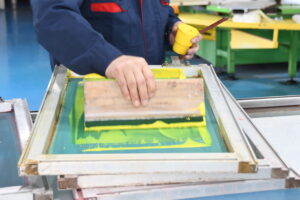Adhesive screen plays a crucial role in various industries, from printing to automotive repairs. Discover its functions, types, and importance in achieving precision and quality.
Understanding the Role of Adhesive Screen in Modern Applications
In the realm of modern manufacturing and repair processes, adhesive screens have become an indispensable tool. Whether in the vibrant world of screen printing or the critical field of automotive windshield repair, adhesive screens ensure precision, stability, and durability. This article delves into the science behind adhesive screens, their applications, and why they are essential in numerous industries.
The Fundamentals of Screen Printing Adhesive
Screen printing is an art form that relies heavily on precision and stability. The process involves applying ink through a mesh screen onto a substrate, such as fabric or paper. One of the key components that enable this process to achieve high-quality results is the adhesive screen. This adhesive layer holds the substrate firmly in place, preventing movement during ink application and ensuring crisp, accurate prints.
Adhesive screens come in various types, each tailored to specific materials and applications:
- Water-based adhesives: These are gentle on delicate fabrics and easy to clean up. They provide a light hold, making them ideal for soft textiles.
- Solvent-based adhesives: These offer a stronger bond, suitable for heavier or slicker materials. They are often used in industrial settings where durability is paramount.
Most screen printing shops prefer spray adhesives due to their quick application and adjustable tack levels. These adhesives are applied to a flat surface or screen printing pallet, often in conjunction with a frame made of durable plastic. This leads to a common question: What is the plastic that holds a screen in place called? Typically, it is polycarbonate, PVC, or polyethylene. These materials are chosen for their durability, lightweight nature, and reliability.
Adhesive Screen in Automotive Windshield Repairs
When it comes to automotive repairs, the importance of adhesive screens cannot be overstated. A common DIY misconception is that super glue can fix a chipped windshield. However, super glue is not designed for outdoor exposure, temperature fluctuations, or the pressure windshields endure. In fact, it can exacerbate the problem over time.
Professionals use specialized adhesive screen products, such as urethane adhesives, which are specifically formulated to bond auto glass to metal frames. These adhesives are flexible, UV-resistant, and safe for long-term use. They ensure that the windshield remains securely in place, providing both safety and durability.
Choosing the Right Adhesive Screen for Your Project
Selecting the appropriate adhesive screen depends on the specific requirements of your project. Here are some guidelines to help you make an informed decision:
- For T-shirts and fabric: Spray adhesives like 3M or AlbaChem are excellent choices. They provide a light tack and can be easily removed without residue.
- For heavier materials or long runs: Liquid adhesives applied with a brush or roller offer a stronger bond and are suitable for continuous use.
- For reusability: Pallet adhesives that maintain their tackiness over multiple uses are ideal for projects involving fabric.

It is also important to consider the screen itself. As previously mentioned, the plastic frame that holds the screen in place is typically made of polycarbonate, PVC, or polyethylene. These materials provide the necessary tension and shape for the screen, ensuring consistent results.
Adhesive Printing: Beyond Labels
Adhesive printing extends far beyond simple labels. It encompasses a wide range of applications, including decals, signage, custom vinyl graphics, and wall art. These materials often have a sticky backing, but proper placement is crucial to avoid design flaws. This is where adhesive screen setups come into play. They ensure that the material remains flat and stable during the printing process, preventing curling, slipping, or misalignment.
In roll-to-roll printing, a steady hold provided by adhesive screens results in cleaner prints, reduced waste, and higher customer satisfaction. Whether you are creating promotional labels or vehicle wraps, the adhesive screen is the unsung hero behind the scenes.
HTV vs. Screen Printing: The Real Differences
Heat Transfer Vinyl (HTV) and screen printing are both popular methods for customizing garments, but they have distinct differences. HTV involves cutting vinyl and heat-pressing it onto fabric. It is ideal for small runs, name personalization, and home use.
Screen printing, on the other hand, uses stencils and ink to create designs. It is better suited for bulk orders, long-lasting prints, and vibrant designs. Both processes benefit from the use of an adhesive screen. In HTV, it helps lay the vinyl flat and hold the garment steady. In screen printing, it ensures that the fabric remains aligned while the ink is applied.
Durability: Screen Print vs. HTV
When it comes to longevity, screen printing generally outperforms HTV. The ink in screen printing penetrates the fabric fibers, making it more resistant to washing and wear. It can withstand dozens, if not hundreds, of washes without cracking or fading.
HTV, while easy to use and vibrant, sits on the surface of the fabric. Over time, especially with heat or abrasion, it may peel or crack. However, a well-executed print using a high-quality adhesive screen can significantly enhance the durability and performance of both methods.
Why Adhesive Screen Matters More Than You Think
Adhesive screens are not just for professionals; they are essential for anyone who values precision and quality. Whether you are printing a new line of t-shirts, creating custom labels, or repairing a windshield, the right adhesive screen setup can make all the difference. Paired with durable plastic frames like PVC or polycarbonate, adhesive screens provide control and confidence in every project.
In conclusion, the next time you embark on a printing or repair project, remember that the foundation of success lies in the unseen details—the adhesive screen that holds everything together.


